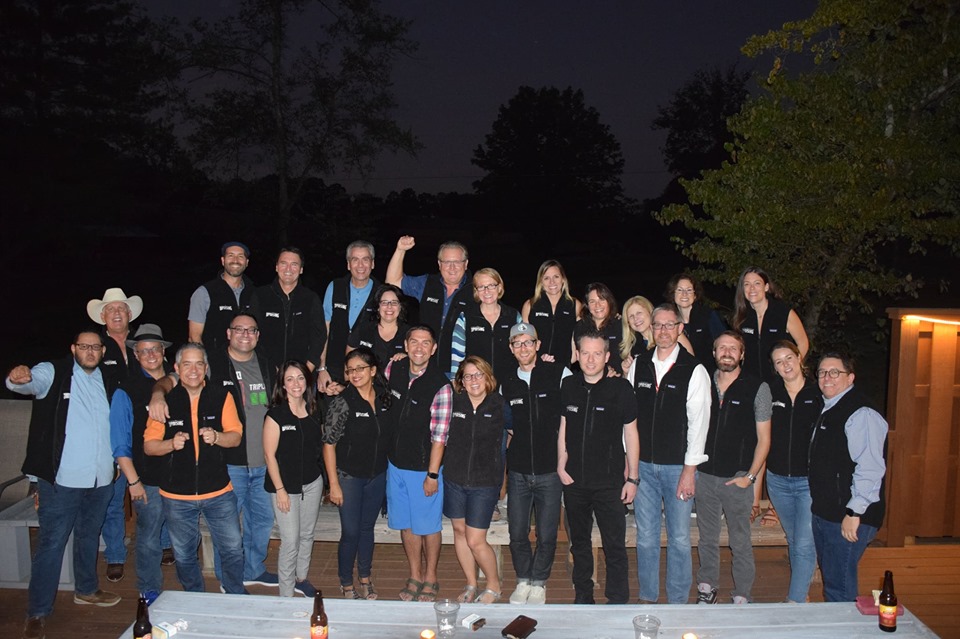I was cornhole oblivious until last week.
If you are like I was – oblivious – cornhole is bean bag toss game that may date back as far as the 14th century in Germany and has been played for decades in the Midwest.
Cornhole players take turns tossing a 16-ounce bean bag toward a plywood board with a hole, trying to get the bag to land in the hole or at least on the board. Each player tosses four bags per round, scoring three points for a bag in the hole and one for each landing on the board. We played until a team reached 15, but my research indicates the official rules say play to 21.
My cornhole oblivion ended last week at an incredible marketing retreat called The Uprising in Maryville, Tennessee. My eternal gratitude to Keith Jennings, VP of Community Impact at Jackson Healthcare, for his willingness to team up with a newbie. Maybe it was just beginner’s luck, but I scored our winning points!
Athletic bragging rights rarely come my way so I take them when I can.
At The Uprising, thirty marketing thought leaders came together to share expertise and to discuss the future of marketing. I was honored to be one of them.
 Marketing expert and author Mark Schaefer created The Uprising inspired by his book Marketing Rebellion. Marketing Rebellion documents the seismic shifts that have occurred in marketing and how most companies are way behind heeding these shifts. If you have not read it, you should. (I receive nothing for recommending this book.)
Marketing expert and author Mark Schaefer created The Uprising inspired by his book Marketing Rebellion. Marketing Rebellion documents the seismic shifts that have occurred in marketing and how most companies are way behind heeding these shifts. If you have not read it, you should. (I receive nothing for recommending this book.)
Based on the information I gleaned from The Uprising, my reading and my expertise from almost 30 years in marketing and brand strategy, here are 10 insights to keep in mind as you approach your 2020 marketing plans.
#1. Consumers are in control. By consumers, I mean people. Anyone purchasing, using or accessing any brand’s offering in any context. These are the same people writing reviews and talking about your brand with friends, family and colleagues.
As Mark Schaefer referenced in Marketing Rebellion, a McKinsey study showed that two-thirds of the brand touchpoints consumers referenced when evaluating a purchase were human-driven marketing activities. Reviews, social media conversations, word-of-mouth from friends and family, online experts.
Mathew Sweezey, Principal of Marketing Insights for Salesforce.com reported research showing that consumers now notice 500 pieces of “noise” daily, and that 350 of the 500 are consumer-created. Both data points show that consumers do the bulk of marketing for brands.
#2. Brands get customer loyalty by giving first. McKinsey reports that loyalty eludes 90% of consumer categories. High performing brands foster loyalty by demonstrating their loyalty to their customers first. At the most basic level, this means not annoying customers. Mark Schaefer puts it more bluntly, “Stop doing what people hate.”
For example, remember the torturous experience with SiriusXM I described to you last year? SiriusXM finally got with the program last month and renewed my subscription at the same offer I wrangled for the prior three renewals.
But not annoying customers is a low bar. Real loyalty from brands means protecting, respecting and delighting customers.
Protecting customers by not sharing their data. Respecting them by being transparent about data usage, by letting them control their data, by valuing their time and by not insulting their intelligence. Delighting them by delivering value at every touchpoint – responsive and proactive customer service, easy navigation and sought-after information on your website, fun and memorable in-store experiences, entertaining and informative emails.
#3. Brands solve problems, evoke emotions and convey an image. Brands serve functional, emotional and social roles. Investment customers seek to grow their money (functional) and to have confidence that their money is invested with the right advisor (emotional).
Patagonia customers seek clothing that is not only well-made (functional) but also environmentally conscious (social), and they feel joy supporting Patagonia’s environmental efforts (emotional). Patagonia’s customers are happy to be associated with their brand image.
In recent years many brands that succeed on all three fronts have gone even further, using the affinity for their brand to build a community that connects their like-minded audience.
#4. Brand = sum of all experiences. Your brand’s image evolves with every interaction people have with it. This is true not just for customers but employees, vendors, partners, anyone who comes in contact with your brand in any way. Every experience has the potential to bolster your audience’s view of your brand or detract from it.
#5. Marketing’s focus has shifted from messaging to customer experience. Because experiences dictate brand image and because customers now do the bulk of brand messaging, marketing has evolved from crafting messages to designing customer experience.
General Mills launched popular breakfast cereal Cheerios in 1941. From the beginning, Cheerios’ has touted the health benefits of its oats ingredient. For the first 60+ years of the brand’s history, marketing consisted primarily of different ways of communicating those benefits, along with the occasional new flavor introduction.
In recent years, Cheerios’ marketing has shifted to enhance their customers’ experience.
Cheerios features informative videos on its website, including one explaining how they made the product gluten-free. General Mills has placed heart-shaped Cheerios in some boxes and encouraged customers to enter a sweepstakes by posting a picture of their heart-shaped Cheerio on social media. They partnered with Feed America and GenYouth to run a food donation campaign called Good Goes Round and posted videos of the resulting food deliveries.
All these efforts enhance how Cheerios’ customers view and feel about the brand.
Leading brands have included a Chief Experience Officer (CXO) in their executive ranks, acknowledging how important this function is.
As brand expert Denise Lee Yohn explains, really forward-looking brands empower their CXO to preside over both the employee experience and the customer experience, realizing that these two realms are interconnected and equally important to the brand’s success. How employees experience the brand affects how they represent it and how they interact with customers.
#6. One-to-one marketing is expected. Human-to-human marketing will be the gold standard. Customers expect to be addressed personally. One-to-one marketing means sending a single brand message to an individual customer, like sending personalized mass emails.
What really wows customers though is human-to-human contact, something lacking in our world. This is why Zappos deputizes customer service representatives to stay on the phone as long as the customer wants. And why I advocate handwriting thank you notes.
#7. Artificial Intelligence (AI) use will continue to grow. Though this may seem ironic after #6, AI used thoughtfully can enhance customers’ experience.
AI is a software tool that learns, processes large amounts of data and homes in on what is important. It differs from automation which is rules based and saves humans time by executing manual tasks. Voice activated devices like Echo and Google Home are applications of AI. If you talk to Siri, Cortana or Bixby, you are engaging AI. AI shines when used to highlight quality leads from prospects’ web interactions, in data analytics and in personalization, to name a few marketing applications.
#8. Word-of-mouth marketing is a stealth tool that will grow in usage. Word-of-mouth has long been considered among the most effective kinds of marketing. Deliberate word-of-mouth marketing is stealth in its human-to-human connection and in authenticity, but not in speed.
Word-of-mouth campaigns focus on identifying advocates who are naturally effusive about your brand and having them meet your audience where they naturally hang out. This is in contrast to influencer marketing, where influencers are selected based on their audience size and composition and paid to spread specific brand messages in their own words. Brands don’t usually pay advocates but sometimes reward them with special experiences.
#9. Social media’s future is unpredictable. U.S. based social media platforms like Facebook and Twitter are under investigation, facing the prospect of regulation, and struggling to maintain users’ privacy and the integrity of their reputations. Expect to see growing use of China-based platforms WeChat and Tiktok. In the future, much of the interaction may shift to messaging apps like Facebook Messenger, WhatsApp, Viber and WeChat.
Your brand’s best defense here is to gain and maintain your customers’ contact information and to connect directly whenever possible. On social media, you are at the mercy of the platforms’ rules and existence. If they change algorithms or somehow cease to exist, you’ll lose the investment you made there along with the audience you attracted.
That’s not to say your brand should not be on some social media platforms. With your social media efforts, focus on personal connection and engagement, not number of followers and likes. The former enhances your brand, the latter does little for it.
#10. Innovative brands focus on meaningful metrics and try new ways of measuring success. Getting lost in big data and measuring everything possible does not necessarily lead to brand growth. Make sure the metrics you prioritize are meaningful.
Sometimes the smaller ones, like deep conversations at a trade show and resulting meetings, can do more to propel your brand than content clicks and downloads. Creative metrics, like identifying product issues and new product ideas from social media listening, can also support your brand more than likes and shares.
I left The Uprising feeling optimistic about marketing’s future because it is moving in a positive direction, one that will enhance people’s experiences and lives.
Questions? Comments? Call or email me. I’ll be here hoping my cornhole luck holds for my next marketing conference, MarketingProfs’ B2B Forum in Oxon Hill, Maryland next week!
If you liked this post, you’ll love the next one.
To have future posts sent to your inbox...


